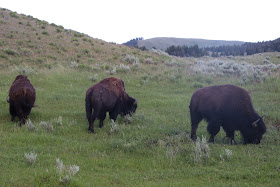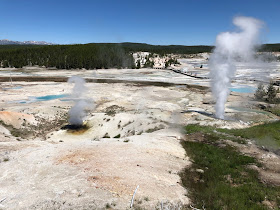It has been quite here as of late, and that is mainly because we have been on vacation. Long, long ago, last winter, we had said we should take a family vacation in honor of our eldest heading off to college. Up till now, all of our vacations have been family get-togethers or reunions with old friends. We'd never gone somewhere just to see things and relax. So vacation for vacation's sake was the goal of this vacation, and the graduate suggested Yellowstone as the place she'd like to see.
As the crow drives (if crows could drive) it is twenty-five hours of drive time from our town outside of Columbus, OH to Yellowstone's north entrance. We took it in three days.
The first day was a big driving day. Our goal had been to leave the house as six, and we pulled out of the driveway by six-thirty, which is near record-breaking promptness for our family of nine. We drove to Fort Dodge, Iowa with not much more than a couple pauses at rest stops to consume sandwiches made of deli meat and cheese from the cooler. Despite the pandemic, rest stops were mostly open and were a reliable source of bathrooms as were gas stations. Many fast food places were drive through only.
The kids became connoisseurs of rest stop seesaws.

Out plan on Day Two, was to drive from Fort Dodge to De Smet, South Dakota and see various Laura Ingalls Wilder related sites, then continue on a couple hours before stopping for the night.
De Smet is well worth a visit. We'd listened to
On the Shores of Silver Lake as we drove and this turned out to have been the perfect book to have listened to since the first thing you see on the
Historic Homes tour is the surveyor's house in which the Ingalls spend the winter of 1879/80 in that book. Laura describes it as the largest house they had yet lived in, and that really tells you something because it is quite small.
Right next to the surveyor's house (which itself has been moved from its original location) is the one room schoolhouse which Laura and Carrie attend in The Long Winter and Little Town on the Prairie. It's been restored to something like it's original condition after having served as a home for some years after being used as a school.
During normal times, this visit is a lot more hands on, but due to the nature of the times, were weren't supposed to be touching anything.
The final original Ingalls building on the tour is a few blocks away, and is the house in town which Charles Ingalls built for the family two years after Laura's marriage. This house (expanded several times by Mr. Ingalls until it reached its current configuration) looks like a fairly standard Victorian wood house, so the impressive thing here is perhaps that it was built almost exclusively by one man who wasn't even a builder by trade. Here you can also see a lot of original Ingalls artifacts.
The gift shop building back at the start of the tour not only has a number of Little House related books, but also some displays of family documents, pictures, etc. Overall, the tour was well worth it, and we enjoyed it a lot. We took the opportunity to pick up a copy of the annotated Pioneer Girl (Laura's original unpublished memoir of which the children's series was an expansion and fictionalization) and Rose Wilder Lane's two novels based on her mother's materials.
The other De Smet attraction is the
Ingalls Homestead living history attraction. This is on the original homestead land where Charles Ingalls had his claim. They've built a recreation of the homestead shanty in its final expanded form described in Little Town on the Prairie, and that recreation stands pretty much where the original house stood. A few of the original cottonwood trees which Pa planted still stand on the property. Other buildings are recreations of other buildings described in the books or are used in the living history activities. We arrived just as things were shutting down at 5:00pm, but the entire thing is open without admission cost after their business hours are over, so we were able to look around. It was fascinating to see the size of a homestead claim and what the actual topography was like in the area after having read the books all these years.
One of the highlights for the kids was that there were kittens in the barn that wanted to be played with.
The next day we drove about seven hours, but with an extended stop in the middle to visit Badlands National Park. I hadn't known much about Badlands prior to this trip. I'd picked it because it was directly along the way and the pictures I saw online were impressive. We were really glad we made the stop. The badlands themselves are amazing to look at, and since they're formed by erosion the park service allows people to walk around on them as they like. We also got the chance to see prairie dogs and big horn sheep while in the park.
We had one more stop before going to Yellowstone itself: the Museum of the Rockies. This is the final resting place of Big Al, the allosaurus who lived fast and died young in our favorite dinosaur special,
The Ballad of Big Al, (narrated by Kenneth Branagh.) It turns out that The Museum of the Rockies doesn't see Big Al as the central star of their show the way that we did, but he's there and worth the visit.
We had wanted to stay somewhere nice while visiting Yellowstone, and of course we needed somewhere that could accommodate nine people. We found
a historic log house on land ten minutes drive from the north entrance. If you ever need a place to stay with a large family near Yellowstone, we can't recommend it enough. It was so wonderful we wished we could spend more time just hanging around there.
The park itself is amazing, and the two and a half days we had looking around inside were just enough to hit a few highlights. You could easily spend a week just on Yellowstone itself. If planning your own trip, keep in mind that the drive time between different parts of the park is significant. We put three hundred miles on the van just driving around the park.
We did the usual volcanic features: Old Faithful, Mammoth Hot Springs, Norris Geyser Basin, Grand Prismatic Hot Spring. We also hiked the south rim trail along the "grand canyon of Yellowstone" and saw the waterfalls. That was a really good hike, and MrsDarwin and I wished we could have done more like it, but it wore the kids out badly and features a few points where it was very necessary to hold on to the younger kids lest any small adventurers take a sudden plunge down a slope. We also took an evening drive up through the Lamar Valley. We got to see lots of bison on that drive, and also spotted a wolf in the distance (no picture, as without strong binoculars it just looked like a moving black speck) and fell in with a group of wolf chasers who had been following it as it ran parallel to the road taking a hunk of bison meat home to its pups. We spent an exciting forty-five minutes driving with the wolf chasers from overlook to overlook and watching the wolf.








Since we were so far west, we drove another day to visit a college friend who farms in central Idaho. We'd gone through a lot of farmland by the point, but nothing quite compared with the huge fields on Idaho's high prairie. Our friend's family has about six thousand acres under cultivation.
From this furthest point, it was three long driving days back to Ohio. We put nearly 5,000 miles on the car in total during the vacation, but the kids were troopers and we saw amazing amounts of this wide country.































